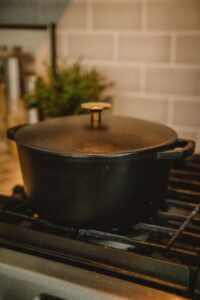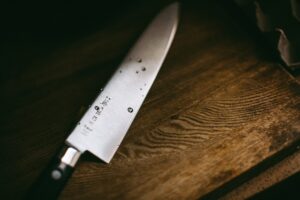Are you looking to upgrade your cookware but feeling overwhelmed by the countless options available? You’re not alone. Many consumers have questions about which pots and pans are the best for cooking. From safety concerns to durability and performance, it can be challenging to navigate through all the information. In this article, we will explore some of the key considerations when choosing cookware, providing you with essential insights to help you make an informed decision. Discover the best pots and pans for cooking that will enhance your culinary experience and make your time in the kitchen more enjoyable.

This image is property of images.unsplash.com.
Best Pots And Pans For Cooking
Materials
When it comes to choosing the best pots and pans for cooking, one of the most important factors to consider is the material. Different materials have their own unique qualities and can affect the cooking performance, durability, and ease of use of your cookware. Here are some popular materials to consider:
Stainless Steel
Stainless steel cookware is a popular choice for many home cooks due to its durability and versatility. It is resistant to rust, corrosion, and staining, making it long-lasting and easy to clean. Stainless steel pots and pans are also non-reactive, meaning they won’t interact with acids or alkaline ingredients in your food, thus preserving the flavor and quality. They can be used on various heat sources, including induction, gas, electric, and ceramic cooktops. However, stainless steel has relatively poor heat conductivity, so it is often layered with other materials like aluminum or copper to improve heat distribution.
Cast Iron
Cast iron cookware has been used for generations and is beloved for its exceptional heat retention and even heating capabilities. It is perfect for dishes that require long, slow cooking or browning, as it can maintain a steady temperature even when the heat source is turned down. Cast iron pans develop a natural non-stick surface over time when properly seasoned, making them great for searing, frying, baking, and even roasting. However, cast iron cookware is heavy and can be prone to rust if not properly cared for. It also takes longer to heat up compared to other materials.
Non-Stick
Non-stick cookware is a popular choice for those who want to reduce the amount of oil or fat used in their cooking and make cleanup a breeze. The non-stick coating prevents food from sticking to the surface, making it easy to flip pancakes, sauté vegetables, or fry eggs without worrying about them sticking or breaking apart. Non-stick pans are lightweight, heat up quickly, and are generally easy to clean. However, they can be less durable than other types of cookware, and the non-stick coating can wear off over time, requiring replacement.
Copper
Copper cookware is known for its excellent heat conductivity, providing quick and even heating throughout the pan. This allows for precise temperature control, making it a favorite among professional chefs. Copper pots and pans are often lined with a layer of stainless steel or tin to prevent the reactive copper from interacting with acidic ingredients. Copper cookware is also aesthetically pleasing, adding a touch of elegance to any kitchen. However, copper can be quite expensive, and it requires more maintenance to keep it looking shiny and prevent tarnishing.
Carbon Steel
Similar to cast iron, carbon steel cookware is highly durable and excellent at heat retention. It is often used in professional kitchens for high-heat cooking methods like stir-frying or searing. Carbon steel pans can be seasoned to develop a natural non-stick surface, making them suitable for a wide range of cooking tasks. They are also relatively lightweight compared to cast iron. However, carbon steel cookware requires proper seasoning and maintenance to prevent rusting and prolong its lifespan.
Induction Compatibility
If you have an induction cooktop, it’s important to choose cookware that is compatible with this specific heat source. Induction cooking utilizes magnetic fields to heat the cookware directly, which means not all materials can be used. Here’s what you need to know:
Induction Compatible Cookware
Induction compatible cookware is specifically designed to work with induction cooktops. It typically features a magnetic base made of materials like stainless steel or cast iron that can interact with the magnetic field and efficiently heat up. Induction compatible cookware ensures quick and even heating, making it ideal for precise cooking techniques. Always check for the “induction compatible” label or look for cookware with magnetic properties to ensure compatibility with your induction cooktop.
Non-Induction Compatible Cookware
Certain materials, such as aluminum, copper, and glass, are not inherently magnetic and therefore cannot be used directly on induction cooktops. However, there are workarounds if you have non-induction compatible cookware that you’d still like to use. One option is to purchase an induction interface disk, which is a metal plate that is placed between the cookware and the induction cooktop. The disk heats up and transfers the heat to the non-magnetic cookware. Another option is to invest in an induction converter disc, which converts the magnetic fields into heat. Keep in mind that these solutions may affect the overall cooking performance and efficiency.
Top Cookware Options For Your Kitchen
Durability
When investing in pots and pans, durability should be a top consideration. You want cookware that can withstand frequent use, high heat, and the rigors of everyday cooking. Here are some factors to consider when looking for durable cookware:
Long-lasting Cookware
To determine the longevity of cookware, consider the materials used and their quality. Stainless steel, cast iron, and carbon steel are generally long-lasting materials that can withstand heavy use without warping or deteriorating over time. Additionally, look for cookware that has a thick and sturdy construction to ensure durability. Avoid cookware with thin or flimsy walls, as they can dent easily and may not hold up well in the long run.
Scratch-resistant Cookware
Cookware that is resistant to scratches and dents is not only more aesthetically appealing but also more durable. Stainless steel and cast iron are known for their scratch-resistant properties, making them great choices for long-lasting cookware. However, be cautious when using metal utensils on non-stick or enamel-coated cookware, as they can cause scratches and compromise the non-stick surface.
Dishwasher-safe Cookware
If you prefer the convenience of using a dishwasher for cleanup, it’s important to choose cookware that is dishwasher-safe. Look for cookware that explicitly states that it is dishwasher-safe or check with the manufacturer’s recommendations. Stainless steel, cast iron, and certain non-stick cookware (check the manufacturer’s instructions) are usually safe for dishwasher use. Keep in mind that frequent dishwasher use may cause some cookware to lose its shine or develop discoloration over time.
Heat Conductivity
Even heat distribution and efficient heat conductivity are crucial for achieving consistent cooking results. Here are some materials known for their excellent heat conductivity:
Aluminum Cookware
Aluminum is a lightweight and affordable material that offers excellent heat conductivity. It heats up quickly and evenly, ensuring that your food cooks uniformly. However, aluminum is a reactive material, and when used in its pure form, it can interact with acidic or alkaline ingredients, affecting the taste and color of your food. To combat this, most aluminum cookware features a non-reactive coating or is anodized, a process that creates a layer of oxide that prevents leaching and makes the surface durable and non-stick.
Copper Cookware
Copper is one of the best heat conductors available, providing rapid and precise heat distribution. It responds quickly to changes in temperature, allowing for precise control over cooking. Copper cookware is often lined with a layer of stainless steel, tin, or silver to prevent the reactive copper from interacting with certain foods. The combination of copper and stainless steel is particularly popular due to its excellent heat conductivity and durability.
Clad Cookware
Clad cookware, also known as tri-ply or multi-ply cookware, consists of multiple layers of different materials, typically stainless steel, aluminum, and/or copper. The combination of these layers provides excellent heat conductivity, retention, and even cooking performance. The outer layer of stainless steel provides durability and compatibility with various heat sources, while the inner layers of aluminum or copper ensure rapid and uniform heat distribution. Clad cookware is often pricier, but it offers exceptional heat conductivity and the benefits of different materials in one.

This image is property of images.unsplash.com.
Weight
The weight of your cookware can have an impact on your cooking experience and convenience. The ideal weight for you depends on your personal preference and cooking style. Here are some considerations for lightweight and heavyweight cookware:
Lightweight Cookware
Lightweight cookware is favored by those who value easy maneuverability and less strain during cooking. It is often made of aluminum or stainless steel, which are lighter metals compared to cast iron or carbon steel. Lightweight cookware is especially beneficial for those with limited strength or mobility, as it allows for effortless lifting, stirring, and pouring. However, keep in mind that lightweight pans may be more prone to warping or denting over time.
Heavyweight Cookware
Heavyweight cookware, such as cast iron or certain stainless steel pans, offers excellent heat retention and durability. The weight of the cookware provides stability and prevents hot spots, ensuring even cooking. Heavy pans are particularly useful for tasks that require longer cooking times, deep frying, or dishes that benefit from the heat retention properties of cast iron. However, they can be cumbersome to handle for some and may require more effort when lifting or stirring.
Versatility
Having versatile cookware allows you to expand your cooking repertoire and experiment with different techniques. Here are some features to look for in versatile cookware:
Oven-safe Cookware
If you enjoy finishing your dishes in the oven or want the flexibility to start on the stovetop and finish under the broiler, it’s important to choose oven-safe cookware. Stainless steel, cast iron, and certain non-stick pans are typically safe for oven use. Check the manufacturer’s instructions for specific temperature limits, as some cookware may have limitations when it comes to high-temperature cooking.
Broiler-safe Cookware
Cookware that is broiler-safe can withstand the intense heat produced by the broiler. This is particularly important if you enjoy broiling steak, fish, or vegetables to achieve a caramelized or charred exterior. Stainless steel and cast iron are generally safe for broiling, but be cautious when using non-stick or coated pans, as they may have temperature restrictions.
Dishwasher-safe Cookware
As mentioned earlier, dishwasher-safe cookware allows for easy and convenient cleanup. Check the manufacturer’s instructions to ensure that your cookware can be safely cleaned in the dishwasher before purchasing. Keep in mind that frequent dishwasher use may affect the appearance or integrity of some cookware, especially non-stick coatings.

This image is property of images.unsplash.com.
Size and Shape
The size and shape of your pots and pans can significantly impact their versatility and functionality. Here are some common types of cookware to consider:
Saucepan
Saucepans are versatile and frequently used cookware in the kitchen. They come in various sizes and typically have a long handle and a lid. Saucepan sizes range from small 1-quart pans for reheating leftovers or making sauces to larger pots suitable for boiling pasta or preparing stews. A saucepan with a pouring spout can be particularly convenient for controlled pouring without any spills.
Skillet/Frypan
Skillets, also known as frypans, are shallow, flat-bottomed pans with slightly sloping sides and a long handle. They are used for tasks like frying, searing, browning, and sautéing. Skillets are available in various sizes, with larger sizes being versatile enough to cook larger quantities or accommodate whole fish or roasts. Look for skillets with a non-stick coating or those made of stainless steel or cast iron for optimal performance.
Stockpot
Stockpots are large, deep pots with handles and tight-fitting lids. They are ideal for cooking large batches of soups, stocks, stews, or boiling pasta. Stockpots can have a wide base and tall sides to accommodate a significant volume of ingredients while preventing boilovers. Handles that are comfortable to grip and a secure lid are essential features to consider when choosing a stockpot.
Dutch Oven
Dutch ovens are heavy, deep pots with thick walls and a tight-fitting lid. They are known for their versatility and ability to evenly distribute heat. Dutch ovens are suitable for long, slow cooking, making them perfect for braising, simmering, or baking bread. Their ability to go from stovetop to oven makes them incredibly versatile. Look for a Dutch oven with a durable enamel coating or a well-seasoned cast iron option.
Grill Pan
Grill pans are designed to mimic the grill marks and flavors of outdoor grilling while being compatible with stovetop cooking. They feature raised ridges that allow fat to drain away, creating those desirable grill marks. Grill pans are excellent for searing meat, fish, or vegetables, giving them a charred, smoky flavor. Look for a grill pan with a non-stick coating or one made from cast iron, as they hold and distribute heat effectively.
Roasting Pan
Roasting pans are typically large, rectangular or oval-shaped pans with low sides and handles. They are used for roasting meats, vegetables, or poultry in the oven. Roasting pans often come with a removable rack that elevates the food, allowing hot air to circulate and facilitate even cooking. Look for a roasting pan with sturdy handles and a non-stick or stainless steel construction for easy cleanup.
Price Range
Cookware comes in various price ranges to suit different budgets. Here’s a breakdown of the different price categories:
Affordable Cookware
Affordable cookware options are readily available and offer quality performance at a budget-friendly price. Stainless steel and aluminum cookware sets are usually more affordable compared to high-end options. Look for cookware made from durable materials with a solid construction to ensure longevity and cooking performance. While they may not have all the bells and whistles of higher-priced options, affordable cookware can still fulfill your cooking needs.
Mid-Range Cookware
Mid-range cookware usually features a combination of value, quality, and additional features. Tri-ply stainless steel or clad cookware is often found in this price range. These sets offer the benefits of multiple layers of different materials for excellent heat conductivity and durability. Mid-range cookware may include features like a non-stick coating or ergonomic handles, providing a balance between affordability and performance.
High-End Cookware
High-end cookware typically utilizes premium materials and advanced technology to offer exceptional performance and durability. Copper cookware sets or high-quality clad cookware can be found in this price range. These sets often feature impeccable craftsmanship, superior heat conductivity, and stylish designs that elevate your cooking experience. High-end cookware is an investment and is more likely to last for years with proper care.
Warranty and Customer Support
When shopping for pots and pans, consider the warranty and customer support provided by the manufacturers. Here’s what to look for:
Quality Brands with Warranty
Many reputable cookware brands offer warranties that provide peace of mind and ensure the quality of their products. Check the warranty details, including the duration and coverage. Warranty coverage can vary, but it typically includes defects in materials and workmanship. Choosing cookware from a trusted brand with a solid warranty can offer protection against any manufacturing defects or premature damage.
Responsive Customer Support
Good customer support is essential for any purchase, and cookware is no exception. Look for brands that have a reputation for responsive and helpful customer support. Responsive customer support can assist with any questions or concerns you may have about your cookware, provide guidance on proper usage and care, and handle any warranty claims efficiently. A brand with reliable customer support demonstrates a commitment to ensuring customer satisfaction and a positive experience.
Reviews and Recommendations
To make an informed decision about the best pots and pans for cooking, it’s helpful to consider expert reviews and user recommendations. Here’s why they matter:
Expert Reviews
Expert reviews from trusted sources, such as culinary professionals, chefs, or reputable cooking publications, provide valuable insights into the performance, durability, and overall quality of different cookware options. Expert reviews often take into account factors like heat distribution, ease of use, durability, and value for money. Reading expert reviews can help you narrow down your choices and understand what to expect from specific cookware brands and models.
User Recommendations
User recommendations offer a real-world perspective on the cookware’s performance and durability from those who have used it in their own kitchens. User reviews and testimonials provide valuable insights into how the cookware handles everyday use, specific cooking tasks, and long-term performance. Reading user recommendations can help you identify any potential issues or limitations of the cookware that may not be evident from expert reviews alone.
Cookware Sets
If you’re looking to invest in a comprehensive collection of pots and pans, consider purchasing a cookware set. Cookware sets often offer a variety of sizes and types of pots and pans that cover a range of cooking needs. The included pieces are typically designed to work well together and provide consistent cooking performance. A cookware set can be a convenient and cost-effective way to equip your kitchen with the essentials, especially if you’re starting from scratch or looking to upgrade your existing cookware collection.
Choosing the best pots and pans for cooking is a personal decision that depends on your cooking style, preferences, and budget. By considering the material, induction compatibility, durability, heat conductivity, weight, versatility, size and shape, price range, warranty and customer support, as well as reviews and recommendations, you can make an informed choice that enhances your cooking experience and yields delicious results. Remember to prioritize the features that matter most to you and invest in cookware that will withstand the test of time. Happy cooking!

